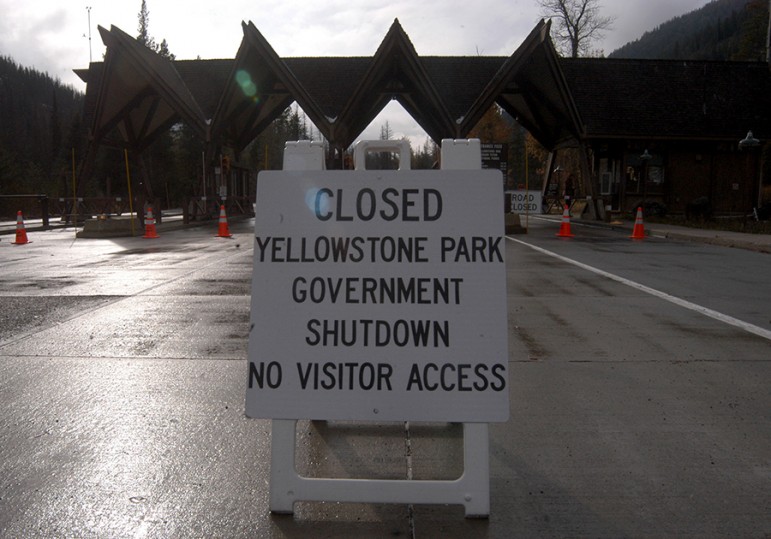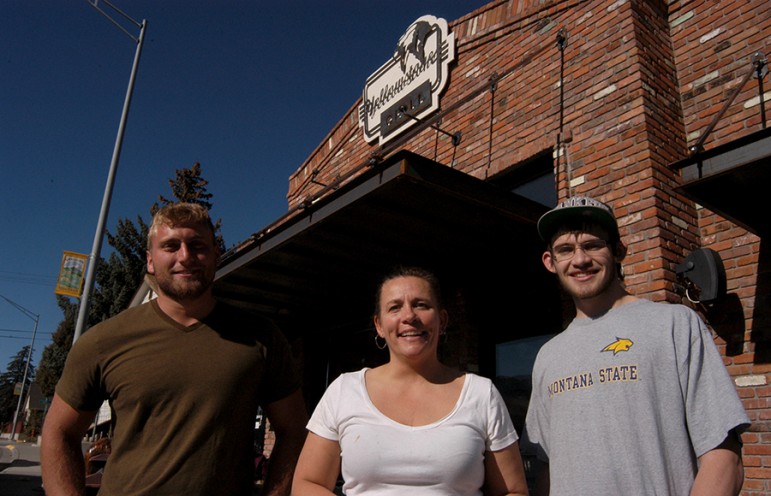
The 16-day shutdown of Yellowstone and Grand Teton national parks in October cost an estimated $21.1 million in lost total visitor and recreation spending to the parks and surrounding communities.
YELLOWSTONE NATIONAL PARK — Congress is not an institution that most Americans would characterize as particularly productive. But the period between Thanksgiving and New Year’s Day is typically even less productive than usual—if that’s possible.
Unfortunately, the new year brings two Congressional deadlines that loom large in the minds of travel and tourism workers in the greater Yellowstone area. Jan. 15 marks the end of government funding under the current continuing budget resolution, and Feb. 7 is the projected date when the nation’s debt ceiling will again need to be raised.
In a region hit hard by government spending squabbles that started the tourism season with park budget cuts under Sequestration and ended the season with a 16-day partial government shutdown that closed Yellowstone and Grand Teton national parks, fears linger that ongoing Congressional dysfunction will again cause chaos for travelers and lost revenue for parks, business owners and workers.
Despite recent assurances from Congressional leaders that a shutdown won’t happen in January, tourism industry insiders and park managers say the new normal of governing by crisis will continue to inflict economic harm on the parks and their gateway communities.
No one appears optimistic that the new year will bring a new approach in Congress that leads to a broad consensus on spending—or even passing a budget.
“It’s ridiculous the way Congress is creating inefficiencies,” said Joan Anzelmo, spokeswoman for the Coalition of National Park Service Retirees. Anzelmo was a National Park Service senior public affairs specialist in Yellowstone, Grand Teton and Washington, D.C., and retired in 2011 after serving as superintendent of Colorado National Monument.
“The agencies try and plan in advance and know what they can budget. In a normal world, budgets are passed a year out,” she said. “We haven’t had a budget for four years now, so it’s budget-by-crisis, with continuing resolutions and threats of shutdowns. It’s no way to run the federal government.”
Anzelmo said the economic toll to parks from the October closures is huge, and equally harsh for gateway towns.
Yellowstone National Park lost nearly $300,000 in revenue from entrance fees, permit fees and campsite rentals during the shutdown, according to spokesman Al Nash.
The Yellowstone Association, the park’s primary education partner, lost an estimated $140,000 in gross revenue over the same period, said Daniel Bierschwale, director of sales and marketing. The Association sells books at several stores inside the park and supports the park from those profits and other revenue sources.
But that pales in comparison to more than $5.5 million in lost revenue for concessioners inside Yellowstone.
Superintendent Dan Wenk said the park lost out on franchise fees from concessioners, and the state of Wyoming failed to collect up to $1 million just from lost sales taxes and gasoline taxes inside the park.
The bigger picture is even bleaker. A comprehensive analysis by the National Parks Conservation Association shows the shutdown cost the parks and communities more than $12.3 million in total lost tourism and recreation spending in and around Grand Teton National Park and $8.8 million for Yellowstone.
That amounts to $21.1 million in lost revenue for a regional economy where 90 percent of tourism spending goes directly to small business owners.
For restaurant owner Schalene Darr in Gardiner, Mont., October revenues were about half what they should have been.
“If the park is closed, who’s going to come where we are at the end of the road?” said Darr, who opened the Yellowstone Grill in May as a family business.
Darr said she’s not politically active, and sees no point in complaining to her representatives in Washington.
“Talking to those people doesn’t accomplish anything. It just (ticks) me off,” she said. “It’s disheartening that these are the people running our government.”

Aaron Van Egmond, Schalene Darr and Hayden Darr report that the October shutdown of Yellowstone National Park meant a 50 percent drop in revenues at the Yellowstone Grill in Gardiner, Mont.
Aaron Van Egmond found work at Darr’s restaurant after he was released early from his job as a barista at the Mammoth Hot Springs Hotel, which was closed throughout the shutdown.
Van Egmond left his Utah home in April to work for the season under contract for Xanterra Parks & Resorts, the concessioner that operates hotels inside Yellowstone. Despite what Van Egmond said was every effort by Xanterra to take care of workers during the shutdown—including free meals and lodging—the hotel ended up closing early, costing him hundreds in lost wages through the end of the season.
Rick Hoeninghausen, director of sales and marketing for Xanterra in Yellowstone, said the company had 1,300 workers at the time of the shutdown, and “worked hard to give them what they would have had if the shutdown had not happened.”
“It was the right thing to do,” he said. “They committed to us through the end of the season, and this was no fault of their own.”
Hoeninghausen said Xanterra’s winter bookings are up 20 percent over last year, despite lingering concerns of another shutdown or budget battle that complicates life in the parks.
“It’s always been the indecision that’s the problem, so all you can do is plan for business as usual,” he said.
Business as usual in recent years has meant an unnecessarily complex planning process for park managers struggling to budget for the long term based on stopgap measures from Congress.
“Our management team has meetings upcoming this month and next month to take another in-depth review of our fiscal situation,” Nash said. “We have to have really deep discussions about potential funding scenarios and how we would respond and prioritize our spending.”
Park Service employees have faced a more personal level of uncertainty during ongoing budget wrangling, as well as the unwanted spotlight that comes with political gamesmanship revolving around national parks, Anzelmo said.
“They were very demoralized and they’re tired of being used as pawns in partisan political games. The last thing an employee of the National Park Service wants to do is to stop welcoming visitors or stop taking care of those resources,” she said.
Anzelmo said parks offer a strong visual illustration of the effects of a government shutdown, and become a focus of media scrutiny and Congressional haggling.
Some Yellowstone workers said their paychecks were delayed and that back pay was not reimbursed at the same level as if they had been working during the whole shutdown.
Not even Yellowstone’s superintendent was immune to personal complications from the shutdown. Dan Wenk’s daughter had planned a wedding inside the park, but had to find another location at the last minute.
Wenk said his daughter and her groom “didn’t want themselves or their wedding to be treated any differently than anyone else, and they took it in stride.”
“We had no cancellations, and it turned out just fine,” he said. “It wasn’t the wedding they had planned, but it was a great event.”
Moving a wedding venue is a hassle, but moving mountains of snow on short notice and with a stunted budget is a virtual impossibility.
Opening Yellowstone on time this spring remains a concern in Wyoming gateway towns like Jackson and Cody, both of which chipped in to cover the cost of snow plowing after budget cuts under the Sequester threatened to delay this year’s spring opening.
“It seems like it’s always a budget fight and Yellowstone, being a flagship park, takes a high-profile hit,” said Scott Balyo, executive director of the Cody Country Chamber of Commerce.
Balyo said local business leaders are already talking with the Park Service about ways to ensure an on-time Yellowstone opening regardless of what Congress decides.
“Our people in Congress understand the importance of Yellowstone and Grand Teton, but there’s such polarization, they can’t even make the statement that this is going to get better,” he said.
“The clock is ticking, so I’m really hoping that behind the scenes, there’s some serious negotiations,” Balyo said. “Otherwise, we’re right back in the same situation.”
Contact Ruffin Prevost at 307-213-9818 or ruffin@yellowstonegate.com.
CORRECTION: This post was edited to correctly identify the Yellowstone Association as the primary education partner of Yellowstone National Park.

Amen, Brother Prevost.
Most folks do not realize that the Park Service budget was pseudo-sequested about 20-30 years ago. Yellowstone in particular had been used as a cash cow to fund smaller less visited Parks and civil war battlegrounds etc. Yellowstone hasn’t gotten adequate or reliable funding for basic maintenance and infrastructure since Reagan. Congress raked in the gate fees to the US General Fund, then was stingy in re-appropriating it back to the Park.
The situation has gotten markedly worse with this one-two punch of Sequestration and Shutdown thanks to the ideological 110th-114th Do Nothing Congresses . And here we go again…Sequestration , Part II. I’m sure the Cod Chamber has resigned itself to another year of having bake sales and beg-a-thons to pay for next spring’s snowplowing on Sylvan Pass. Grrrr…..